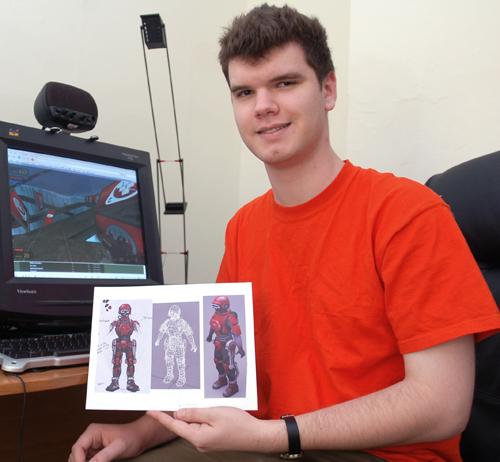Student designs images for hit online ‘mod’ games

William Smith, junior in LAS, holds snapshots of his work that he does as a volunteer for the SourceForts modification game for the website www.sourcefortsmod.com in his apartment, Oct 31, 2006. Will creates 3D players by making a 3D mesh and skeleton fro Dan Hollander The Daily Illini
Jan 24, 2007
Last updated on May 12, 2016 at 07:14 a.m.
Plenty of students on campus are video gamers, and plenty of those gamers are PC gamers. Any active PC gamer is familiar with the Half-Life franchise of first-person shooters, where players control their mute hero, Gordon Freeman, through alien invasion and the resulting aftermath.
Equally well-known, apart from the single-player experience of the games, is the multi-player experience found using the Internet to go head-to-head against random foes.
Among this culture, rise the “modders.”
A “mod” is the Internet shorthand for a user-created modification to the original game, which is then distributed and played online to give the players new experiences outside of what was originally created or envisioned by the game’s developers.
Get The Daily Illini in your inbox!
Will Smith, junior in LAS, is one of these “modders.” Smith played an integral part in the creation of SourceForts, a mod for the game Half-Life 2.
Smith’s role in the mod’s production was in designing the models, or images that the players actually see, of the levels, weapons, players, and every visible object in SourceForts.
Will Smith is a 2D and 3D art designer for the SourceForts mod and has no problem creating a successful game. SourceForts has become an immensely popular mod, currently ranking number two out of all mods for Half-Life 2, at 5.2 million player minutes per month, according to SourceFort’s Web site. That means that every month, players spend 5.2 million minutes playing the mod.
SourceForts has also been narrowed down to one of the top ten mods voted on by gamers in the Mod of the Year Awards, started by the gaming Web site, Mod DB. By the end of the month, SourceForts will know if it has made it in the top five.
Gamers like Derek Meyer are attracted to the mod because of its innovative take on player freedoms.
“I love SourceForts,” said Meyer, sophomore at the University of Nebraska. “There are so many mods on the market, and SourceForts is definitely one of the most innovative ones on the scene.”
In Smith’s mod, players are given an entirely new level of control by being able to build fortifications. Play is done in a capture-the-flag style, and the ability to build your own fortifications to protect a team’s flag allows for a game with nearly limitless re-playability.
“There’s an incredible amount of models and designs that go into the production of a mod on this scale,” Smith said. “We’re hoping to eventually phase out all of the models from Half-Life 2 with our own, but it will definitely take some time. With the help of other talented 3D artists, though, we can probably achieve all of our goals.”
Other 3D artists like Taylor Stieff are impressed with Smith’s mod.
“Will has been a dynamo for us,” said Stieff, sophomore at the Boys’ Latin School of Maryland. “I have worked closely with Will on designing all of the art in the game, and he’s extremely talented. It’s hard to believe you could be able to work so well with somebody without ever having met them.”
Smith said that he was first drawn into the world of gaming with the release of the original Half-Life in 1998 and the subsequent explosion in the popularity of user-created mods for the original game.
He knew that he wanted to get into the modding field when he first saw the physics engine of Half-Life 2 upon release. A physics engine is a gaming term that allows game developers to realistically show accurate movements in a game.
“I was very inspired by the potential uses of the physics engine in Half-Life 2,” Smith said. “In most games, you’re never allowed to break the rules. The environments are unchangeable, and there’s only one way to do things. In a mod like SourceForts, we wanted to put the power back in the player’s hands. We give players control over their environment in the game, and it just means more fun and more strategy.”
Despite the success of SourceForts, Smith intends to continue studying philosophy instead of trying to make a living in the world of online video games.
Yet, Smith said if he were offered a chance to work for a game developer like Valve Studios, the creators of the Half-Life franchise, he would have to jump on it.
“I mostly see SourceForts staying as a small community project for now,” Smith said. “If it keeps growing though, who knows how big it might get?”
The development team is currently in talks with Steam, a Web site that is powered by Valve and allows gamers to download games, like Half-Life and Half-Life 2, and play them on any computer. If the development team for SourceForts gets their game directly acquired over Steam’s Web site, it would increase SourceForts player-base to the largest community of online gamers with more than five million registered users.
“None of us really expect to make a living making video games,” Stieff said. “But look how far it’s already gone. I guess the sky is really the limit. People enjoy playing the mod, and we’re all happy knowing that millions of people are exposed to our 3D art.”
Both Stieff and Smith are thankful for the support of all the mod’s players and look forward to seeing new players discover their creation.
“I would encourage any PC gamer who’s played Half-Life to check out SourceForts,” Smith said. “We have much more planned for the future, and the creation has been a real pleasure.”





